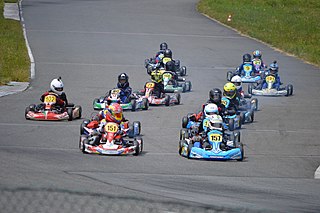
Kart racing or karting is a motorsport discipline using open-wheel, four-wheeled vehicles known as go-karts or shifter karts. They are usually raced on scaled-down circuits, although some professional kart races are also held on full-size motorsport circuits. Karting is commonly perceived as the stepping stone to the higher ranks of motorsports, with most Formula One drivers—including Ayrton Senna, Michael Schumacher, Fernando Alonso, Kimi Räikkönen, Lewis Hamilton, Sebastian Vettel, Nico Rosberg, and Max Verstappen—having begun their careers in karting.
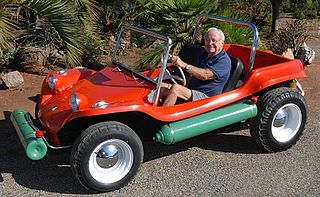
A dune buggy — also known as a beach buggy — is a recreational off-road vehicle with large wheels, and wide tires, designed for use on sand dunes, beaches, off-road or desert recreation. The design is usually a topless vehicle with a rear-mounted engine. A dune buggy can be created by modifying an existing vehicle or custom-building a new vehicle.
Radio-controlled cars, or RC cars for short, are miniature model cars, vans, buses, trucks or buggies that can be controlled from a distance using a specialized transmitter or remote. The term "RC" has been used to mean both "remote controlled" and "radio-controlled". "Remote controlled" includes vehicles that are controlled by radio waves, infrared waves or a physical wire connection. RC cars are powered by one of three energy sources—electricity, nitro fuel or petrol. Electric RC models are powered by small but powerful electric motors and rechargeable nickel-cadmium (Ni-Cd), nickel metal hydride(NiMH), or lithium polymer (LiPo) cells with the latter two being the most used. Both NiMH and LiPo have advantages and disadvantages in various RC applications where NiMH is mainly used for recreational purposes and LiPo for more demanding purposes. There are also brushed or brushless electric motors—brushless motors are more powerful, long lasting and efficient, but also much more expensive than brushed motors.

An all-terrain vehicle (ATV), also known as a light utility vehicle (LUV), a quad bike or quad, as defined by the American National Standards Institute (ANSI), is a vehicle that travels on low-pressure tires, has a seat that is straddled by the operator, and has handlebars. As the name implies, it is designed to handle a wider variety of terrain than most other vehicles. It is street-legal in some countries, but not in most states, territories and provinces of Australia, the United States, and Canada.

A Baja Bug is an original Volkswagen Beetle modified to operate off-road, although other versions of air-cooled Volkswagens are sometimes modified as well. Baja bugs often race in off-road desert races such as the Baja 1000. There are different classes for bugs, namely class 11, class 5 1600, and class 5 unlimited. According to desert racing association Score International, class 11 is a stock VW beetle with modifications limited to ground clearance and strength. Class 5 1600 rules state that a 1600 cc VW engine must be used and the car must have the exterior appearance of a "baja bug" with body modification limited to whatever cutting is needed to install a consumer baja kit. Class 5 unlimited is any 4 cylinder VW-style engine, and it must have Baja-style fenders and side panels, and VW-style suspension.

Car tuning is the modification of a car to optimise it for a different set of performance requirements from those it was originally designed to meet. Most commonly this is higher engine performance and dynamic handling characteristics but cars may also be altered to provide better fuel economy, or smoother response. The goal when tuning is the improvement of a vehicle's overall performance in response to the user's needs. Often, tuning is done at the expense of emissions performance, component reliability and occupant comfort.

A truggy is a type of high performance off-road racing vehicle that combines features from two older existing categories of off-road racing vehicles, trucks and buggies. The first truggies were built for racing in the SCORE and BITD off-road desert racing series, held in Mexico, California, Nevada and Arizona.

A go-kart, also written as go-cart, is a type of small sports car, close wheeled car, open-wheel car or quadracycle. Go-karts come in all shapes and forms, from non-motorised models to high-performance racing karts. Karting is a type of racing in which a compact four-wheel unit called a go-kart is used. Art Ingels created the first go-kart in Los Angeles in 1956.

Homebuilt machines are machines built outside of specialised workshops or factories. This can include different things such as kit cars or homebuilt computers, but normally it pertains to homebuilt aircraft, also known as amateur-built aircraft or kit planes. Homebuilt aircraft or kit cars are constructed by amateurs. Homebuilt computers have been built at home for a long time, starting with the Victorian era pioneer Charles Babbage in the 1820s. A century later, Konrad Zuse built his own machine when electromechanical relay technology was widely available. The hobby took off with the early development of microprocessors and, since then, many enthusiasts have constructed their own computers. A homebuilt vehicle is a wider concept than a kit car. A homebuilt vehicle is a motor vehicle built by an individual instead of a manufacturer. These machines may be constructed "from scratch", from plans, or from assembly kits. Outside of the United States people wishing to build such complex machinery often have no professional networks to rely on for spare parts, plans, or advice in the matter and therefore have to rely on their ingenuity and intuition in order to build a machine that works.

Off-roading is the act of driving or riding in a vehicle on unpaved surfaces such as sand, dirt, gravel, riverbeds, mud, snow, rocks, or other natural terrain. Off-roading ranges from casual drives with regular vehicles to competitive events with customized vehicles and skilled drivers.

The Meyers Manx dune buggy is a small recreationally-oriented automobile, designed initially for desert racing by Californian engineer, artist, boat builder and surfer Bruce F. Meyers. It was produced by his Fountain Valley, California company, B. F. Meyers & Co. from 1964 to 1971, in the form of car kits applied to shortened chassis of Volkswagen Beetles. The car line dominated dune racing in its time, breaking records immediately, and was eventually also released in street-oriented models, until the company's demise due to tax problems after Meyers's departure. New vehicles inspired by the original Manx buggy have been produced by Meyers's re-founded operation, Meyers Manx, Inc., since 2000. The name and cat logo of the brand derives from the Manx cat, by virtue of the tailless breed's and the shortened vehicle's truncated "stubbiness".
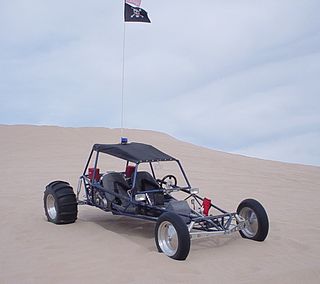
A sandrail, also called a sand rail, rail, or sand car, is a lightweight off-road motor vehicle specifically built for traveling in sandy terrain. Synonymously referred to as dune buggies, a sandrail is a type of speciality vehicle. Sandrails are popularly operated on actual sand dunes. Sandrails can be driven on other types of terrain but are designed specifically for sand.
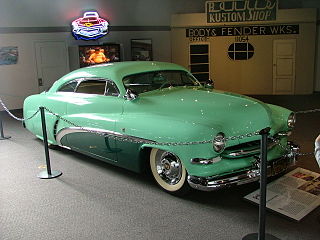
A custom car is a passenger vehicle that has been altered to either improve its performance, change its aesthetics, or a combination of both. Some automotive enthusiasts in the United States want to push "styling and performance a step beyond the showroom floor - to truly craft an automobile of one's own." A custom car in British according to Collins English Dictionary is built to the buyer's own specifications.
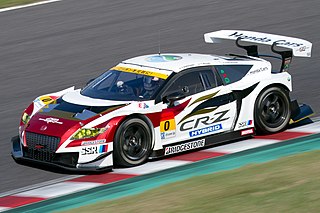
M-TEC Company, Ltd., doing business as Mugen Motorsports (無限), is a Japanese company formed in 1973 by Hirotoshi Honda, the son of Honda Motor Company founder Soichiro Honda, and Masao Kimura. Mugen, meaning "without limit", "unlimited" or "vast", is an engine tuner and parts manufacturer that manufactures OEM parts such as body kits and sports exhausts for Honda. Despite the family relationship, Mugen is not, and has never been, owned by Honda Motor Company; however, Mugen owner Hirotoshi Honda has been the biggest shareholder in Honda since his father's death in 1991.
Kyosho Corporation is a Japanese company based in Tokyo, which operates internationally under the name KYOSHO. The company's main office is located in Chiyoda, and the production headquarters are located in Atsugi, Kanagawa.
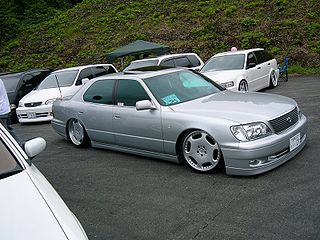
VIP style is a car modification trend that translates from the Romanised Japanese term 'bippu.' It refers to the modification of Japanese luxury automobiles to make them lower and wider in stance, with more aggressive wheels, suspension, and body kits. VIP Style cars are typically large, rear-wheel drive luxury sedans, although automotive enthusiasts sometimes use other cars such as minivans or kei cars.
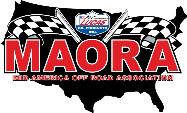
The Mid America Off Road Association (MAORA) is an American off road racing sanctioning. It has sanctioned off road racing events since 1972. Web site www.maoraracing.us

Buggy is generally used to refer to any lightweight automobile with off-road capabilities and sparse bodywork. Most are built either as a kit car or from scratch.
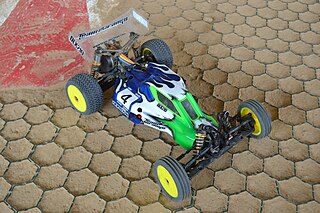
A 1:10 radio-controlled off-road buggy is a 1:10 scale radio-controlled dune buggy designed for off-road racing. These cars are based on their full-scale equivalents that are commonly found in desert racing. The buggies are split into two race categories, two (2WD) and four-wheel drive (4WD). These can easily be distinguished visually by their wheel size at the front. Cars are typically electric powered, but nitro versions do exist but are less common because racing classes exist for electric cars. The class is inexpensive and similar to a number of other classes, and this makes them popular with newcomers. The cars are also known as 1/10 off-road.
Blitzworld Buggies Limited, previously Blitzworld Limited, is a British manufacturer of automobiles.
















